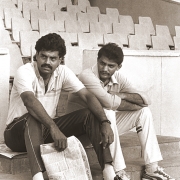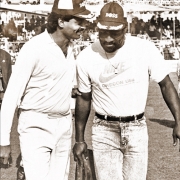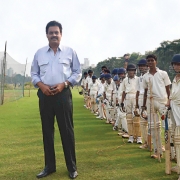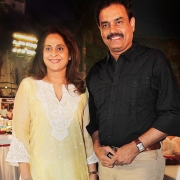
People
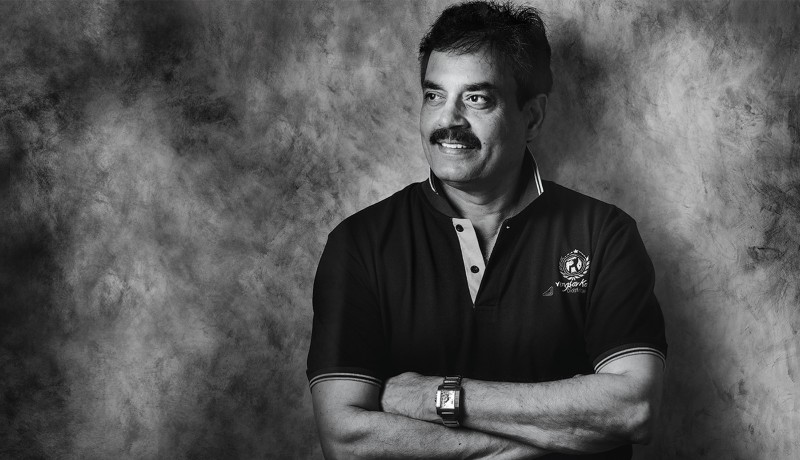
A flamboyant batsman and fierce competitor, Dilip Vengsarkar remains on strike for India by spotting and mentoring young talent, writes Neil Joshi
The doyen of the Indian batting line-up in the 1980s and a fierce competitor, Dilip Balwant Vengsarkar was a flamboyant stroke-maker who enthralled audiences across the world with his finesse, especially his trademark cover drive. After living his dream of excelling in the Gentleman’s Game, the ‘Colonel’ is now leading a new army of young cricketers to fulfil theirs. Standing tall on the sidelines of his eponymous academy at Mumbai’s Oval Maidan, Mumbai—he’s here at 4 pm every day—his pride in his wards is palpable. Today, the 59 year-old is especially impressed by the batting of an 11 year-old lad from a poor family who travels two hours with his elderly grandmother to reach the Maidan; the boy is rewarded by his guru with a cricket kit and warm words of encouragement as the other boys and coaches break out into applause.
Indeed, ever since he hung up his gloves, Vengsarkar has been on a mission to give back to the game. And his academy, which coaches children free of cost, has created cricketers of international repute like Yuvraj Singh, Ajit Agarkar and Ramesh Powar, to name a few. A recipient of the Padma Shri in 1987, the Colonel’s knack of spotting talent is well known; he has served as chairman of the Talent Resource Development Wing of the Board of Control for Cricket in India (BCCI) as well as the BCCI’s chairman of selectors. In November 2014, he received BCCI’s highest cricketing award, the Col C K Nayudu Lifetime Achievement Award. However, he believes his work is far from done. “There is too much of politics in cricket,” he rues. “The game has been infested with people who have never played it. But there is hope. I still have lots to achieve. I want to clean up this mess.”
He shares more on the game, his career and his life off the field in an exclusive interview. Excerpts from the conversation:
Your academy has produced many top-class cricketers. Describe your journey as a coach.
I wanted to give something back after retirement, especially to those kids who come from humble backgrounds and have a hunger for success. My friend Makarand Waingankar saw Oval Maidan and we approached the state government; they gave us this place on a long lease. At that time, it was like an open-air toilet; there were a lot of rag pickers and drug addicts, and prostitution was rampant. One feared to come here after 5 pm. We got help from our friends and well-wishers and put up a fence, created wickets, and planted grass and 60 trees. That was in 1995. Now, it is one of the best grounds in Mumbai. Since then players like Agarkar, Powar and Yuvraj [from the first batch] went on to play for India. And many went on to play for Mumbai in various age groups.
I opened the next chapter of my academy in Mahul [suburbarn Mumbai] in 2004; I applied to the BMC [Brihanmumbai Municipal Corporation] for a place there as children in the suburbs had to travel a long way to come to the Oval Maidan in Churchgate. We planted 120 trees in an area that would have become infested with slums. Then we opened another chapter in 2007 in Chinchwad, Pune. We have excellent training staff at all the academies and we participate in many tournaments. I remember we participated in a tournament in 1996 in Satara and Yuvraj was also there; he travelled in a state transport bus!
Do you feel it’s a good move for former cricketers to become coaches?
Career-wise, I wouldn’t know. If they charge money, it’s good for them. Here, we don’t charge any money—we coach the kids for free. We have sponsors helping us. We had Elf Lubricants sponsoring us for 15 years and in Pune we have Varroc Industries, which makes automobile parts. Right now, we don’t have sponsors at Oval Maidan and Mahul. It is difficult to run the academies without sponsors because the kits have become expensive and we have to pay rent and salaries. We have 400 students across three centres.
You have established your reputation as a talent scout….
In 2002, I was made chief of the Talent Resource Development Wing where I spotted prospective players. The boys I selected were groomed at the National Cricket Academy. The boys I selected comprise the Indian team at the moment, except Ravichandran Ashwin, Mohit Sharma and Mohammed Shami as they weren’t there at the time. However, players like Shikhar Dhawan, Rohit Sharma, Ajinkya Rahane, M S Dhoni, Suresh Raina and Robin Uthappa were all there at the NCA. I really enjoyed that part of my life.
You also served as the chief of selectors….
After I retired, I immediately became chairman of the Mumbai selection committee. At the same time, the BCCI asked me to do the same job. But I didn’t quite agree with zonal representation and I stood for that. I used to get calls after every election and I refused on three to four occasions. In 2007, I took up the task and became chairperson of the selection committee.
How would you rate your tenure as chief selector?
I had a successful tenure. When I took over, India was No. 6 in the International Cricket Council [ICC] rankings and when I left we were No. 1. We beat England in England and won a triangular tournament in Australia for the first time; it has been the only time we have won a tournament of that nature till today. We won the T20 World Cup in 2007; went on to beat Pakistan in Pakistan; and beat Sri Lanka in their backyard in ODIs [one-day internationals]. We gave opportunities to a lot of young cricketers; we made Dhoni the captain and groomed players like Ishant Sharma and Virat Kohli.
At a local level, do you feel Mumbai cricket has taken a backseat?
Cricket has definitely taken a backseat because of a lot of politicking. We have had glorious years in Mumbai cricket. Now, anybody and everybody can come and beat us [in the elections]. In the past four years, Mumbai cricket has gone back at least 10 years. I feel elections are okay but once they are over, everyone should concentrate on cricket and not indulge in measly politics.
Is maidan cricket the best way to improve cricketing standards in Mumbai?
In the earlier days, there was more emphasis on Test cricket. I used to play for Bombay, for my office, Tata, as well as my club, Dadar Union. It was not just me who would play; several Test cricketers got on the field. But nowadays, there is so much international cricket that cricketers don’t get time to play club cricket. We need to revive club cricket because a person may not necessarily play in the Indian team but can surely find his way at the first-class level.
Should only players be involved in the administration of the game?
That is the only way ahead. Cricketers can best run the game because of their cricketing background. If you don’t have that, you have to depend on somebody else. You need to have a competitive system and build good infrastructure and a conducive environment for players, which only a player can understand if he is running the show.
What was it like to receive the Col C K Nayudu Lifetime Achievement Award?
I am very proud I got this prestigious award. It is the highest cricketing award given by the BCCI and I have been part of the BCCI since 1976.
In fact, you are called the ‘Colonel’ of Indian cricket yourself! Who gave you that tagline?
When I was playing for Bombay in Nagpur in 1975, I scored a century against Rest of India led by Bishen Singh Bedi, which had the likes of E A S Prasanna and Madan Lal. Lala Amarnath was doing the commentary on All India Radio; he proclaimed that I batted like Colonel C K Nayudu. It was a great compliment for me. And the press went forward and splashed it all over.
Did you ever believe you would travel such a long road?
When you play as a child, you just play for the love of the game. And then you improve and perform for your school, college, Bombay University, Bombay (Ranji team), West Zone—these are all steps and how you achieve them is an integral part of your success. Being part of the Bombay team helped me a lot. We had a strong team and most of the time we would reach the final of the Ranji Trophy. Having seniors in the side who have played for India also helps you raise the bar.
Was it easy to find your footing in the Indian team?
My start wasn’t so good and I feared I wouldn’t be selected again! Test match cricket in reality was completely different. The wickets I played were totally different. There were a lot of fast bowlers and no spinners faced during the start of my career. I had to make a lot of adjustments and tighten my technique. I had to avoid and curtail certain shots that had a lot of flourish. So that was a big change for me when I started playing international cricket.
You became the only overseas player to score three tons at Lords! How special was that?
When you play, you don’t think. All records happen along the way. I am glad when I scored the hundred at Lords in 1986, India won the Test. It was the first time that India won a Test match at Lords. I am glad to have played a major role in that win. Lords is the ‘Mecca of cricket’ and every cricketer dreams of playing well there. The atmosphere is electrifying when there is a full house; it’s an experience you won’t witness anywhere in the world.
You played with two legends from different generations: Sunil Gavaskar and Sachin Tendulkar. What was it like to share the dressing room with them?
When I played for Mumbai in 1975, Gavaskar was at the peak of his career. In 1989, when I was on the verge of retiring, I played for three years with Tendulkar. Both were amazing cricketers: one, an opening batsman; the other, a middle-order player. There was a boyishness in both these players that added that sense of humour to the team.
What were your best on-field moments?
Winning the World Cup in 1983 was one of the best. But there were other achievements like winning the Benson & Hedges Cup in 1985, and being named ‘Man of the Series’ on the 1986 England tour where I scored back-to-back hundreds—one at Lords and the other at Headingley. And then I was given the mantle of leading the Indian team and I scored a hundred in my first match as captain. So there were many good moments.
Do you think you would have been a successful T20 player?
I would have enjoyed playing T20 cricket because the aggressive style of cricket is in my genes. I could go for the big shots from the word go. And T20 cricket is all about that.
Speaking of the game today, has India exceeded expectations in this World Cup?
If you see the performance of the Indian team in Test cricket before the World Cup, it was very poor. We must thank the ICC for scheduling the India-Pakistan tie as our first match. To beat Pakistan in the first match was a big thing for the team. Pakistan has always been our arch rival and you always have to play your best to beat them. After beating Pakistan, the confidence level was so high that the Indian team looked completely different, which helped us against South Africa. The bowlers started looking better along with the fielders.
Did the bowlers raise the bar?
Yes. And if the bowlers perform well, it definitely helps the captain as well. Mahendra Singh Dhoni is a very good captain. Even if he gets flustered, he doesn’t make it evident and doesn’t get too excited either. It has been very good for the Indian team that Dhoni has led the team for a very long time.
How would you rate the performance of the smaller nations?
I was quite impressed with the performance of Ireland and Zimbabwe. These two teams played really well. Then, there was Afghanistan who beat Scotland. That was a good exposure for them.
What is your take on bringing down the number of teams from 14 to 10 in the next edition of the World Cup?
ICC has a lot of programmes for the development of associate members and those who show improvement. I’m sure a couple of teams would be added to the World Cup. There is a concern that some of the matches will become very one-sided. I feel this can be negated if some of the Test-playing countries send their ‘A’ teams to these upcoming countries; I am sure they will definitely blossom.
According to you, which country should be awarded Test status next?
I think Ireland should get Test status. I say this based on their performance in the World Cup. They looked a formidable team in the tournament.
With Duncan Fletcher set to part ways, who should coach the Indian team?
I always believed an Indian should be the coach. If we have a foreign coach, he will only coach those fringe players that constitute the team. He doesn’t watch anyone playing domestic cricket, so he doesn’t know his options. His job is mainly to coach those 12-13 players. But an Indian would know the psyche of the players; he would know their work ethic and attitude to the game. So that definitely helps. I think Ravi Shastri is doing a tremendous job and he should take the team forward. We have a good staff in place with Sanjay Bangar and Bharat Arun. At this level, we don’t need to coach the boys. It is all mental. The coach’s main role is to strategise.
Would you consider yourself open to the job?
I could be a mentor for the Indian team. I don’t want a coaching job but I would love to mentor the team. I have been a part of the setup for many years and it won’t be a tough job for me.
Who has been your source of inspiration?
There are many cricketers, officials, colleagues, coaches from my school, college and clubs. I have also received guidance from captains of different teams. I can’t really specify any one person as so many people have contributed at some point of time in my career. However, Vasu Paranjape, my club captain, was a mentor to me in many ways.
Speaking of family, tell us about yours. How important has your wife’s contribution been to your life?
I would give 100/100 to my wife Manali. I was touring often and the way she brought up our two beautiful children was exemplary. Our children are fantastic citizens of this country today. My son Nakul is a renowned architect and also has a tremendous passion for photography. My daughter Pallavi has her own label known as ‘PV’, which stands for ‘Pallavi Vengsarkar Creations’. All the credit goes to my wife Manali.
How difficult was it to stay away from family?
When I was playing league cricket in England, which was for a good four months, the whole family came over, so we had a good time. We made so many friends back then that we started going there every year. Even now I go, but I take my academy team along.
Didn’t any of your kids opt to grab the bat?
When my son was young, he had gone to Kodaikanal International School and there wasn’t much cricket there. Thereafter, he did his masters in Italy at Domus Academy. My daughter did her MBA from Durham University, England. Both of them are doing extremely well. Pallavi modeled for my wife’s jewellery line; after that, she got a lot of offers to model and act, but she chose a different career altogether.
Do you and your wife exchange inputs with regard to your respective careers?
All four of us are involved in varied fields so it becomes very interesting to talk about the other’s subject. However, Manali has never been a cricket person, so I have never got on-field advice!
What were your parents’ contribution?
It all started with my parents! They gave me a lot of encouragement during my early days and then, once I got married, Manali became my pillar of strength. My father was a scientific officer at BARC [Bhabha Atomic Research Centre] and my mother hails from Rajapur in the Konkan belt where I was born. A housewife her whole life, she has been the strength of the entire family. She is an amazing cook and I still go to Hindu Colony, Dadar, to grab a meal at least twice or thrice a week! I have fond memories of the place and I often go to Dadar Union Club, which is very close to my place.
Tell us more about your life off the field. Do you have a strict fitness regime?
Though I don’t follow the same regime as my playing days, I work out in the gymnasium at least four days a week. I do a good amount of weights and spend sufficient time on the treadmill. That keeps me going. Food intake is also important; sometimes I cross that line where food is concerned but I try to keep it quite balanced.
How do you recharge your batteries?
Cricket is my oxygen—whenever I go on to a cricket field, it is the best feeling I get and that keeps me going. When I stand on the greens, I feel beautiful inside. When I see a good cricket match or spot new talent, it just makes my day.
Going the distance
Profile
Full name Dilip Balwant Vengsarkar
Born 6 April 1956 (age 59); Rajapur, India
Batting style Right-handed
Bowling style Right arm medium
Scored 110 runs for Bombay in the Irani Trophy at Nagpur 1975
Over 300-run partnership with Sunil Gavaskar against West Indies 1978-79
Part of India’s World Cup winning squad 1983
3 consecutive centuries at Lord’s – Man of the Series 1986
Captain of Indian cricket team 1987-89
Last Test against Australia at Perth 1992
Started the Elf-Vengsarkar Academy 1995
Chairman of All-India Senior Selection Committee, BCCI 2006-08
C K Nayudu Lifetime Achievement Award from BCCI 2014
Photo: Varun Mehta Archival images courtesy: Dilip Vengsarkar Featured in Harmony — Celebrate Age Magazine May 2015
you may also like to read
-
For the love of Sanskrit
During her 60s, if you had told Sushila A that she would be securing a doctorate in Sanskrit in the….
-
Style sensation
Meet Instagram star Moon Lin Cocking a snook at ageism, this nonagenarian Taiwanese woman is slaying street fashion like….
-
Beauty and her beast
Meet Instagram star Linda Rodin Most beauty and style influencers on Instagram hope to launch their beauty line someday…..
-
Cooking up a storm!
Meet Instagram star Shanthi Ramachandran In today’s web-fuelled world, you can now get recipes for your favourite dishes at….



